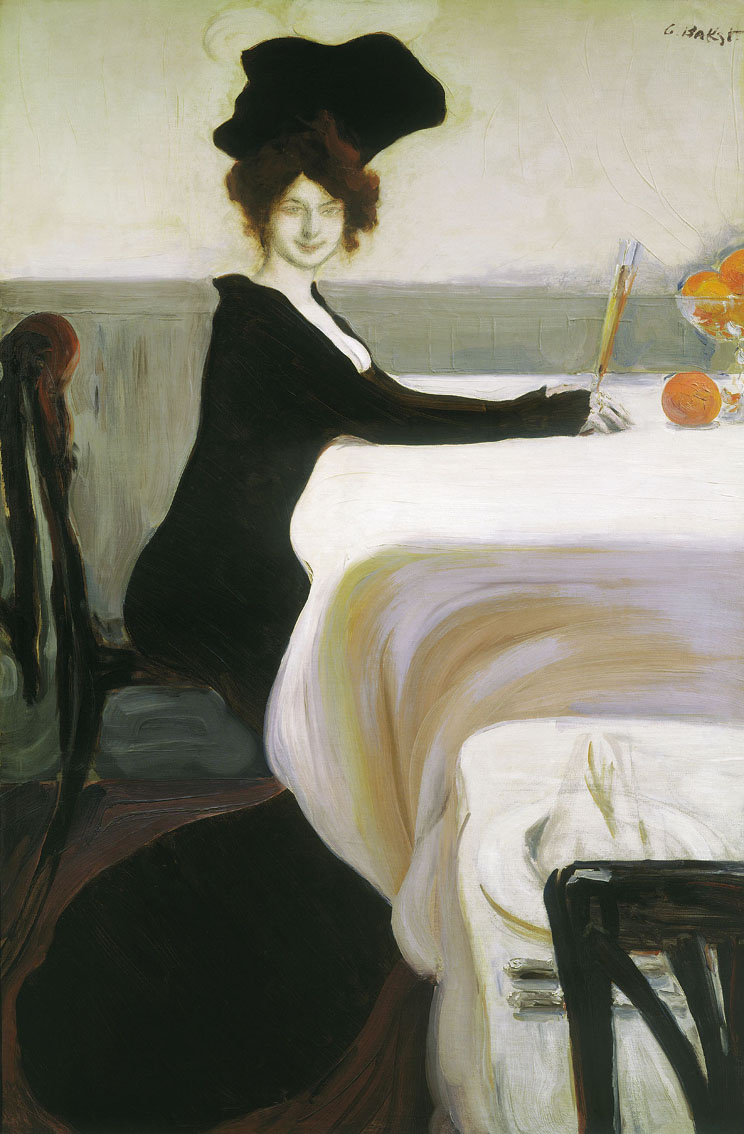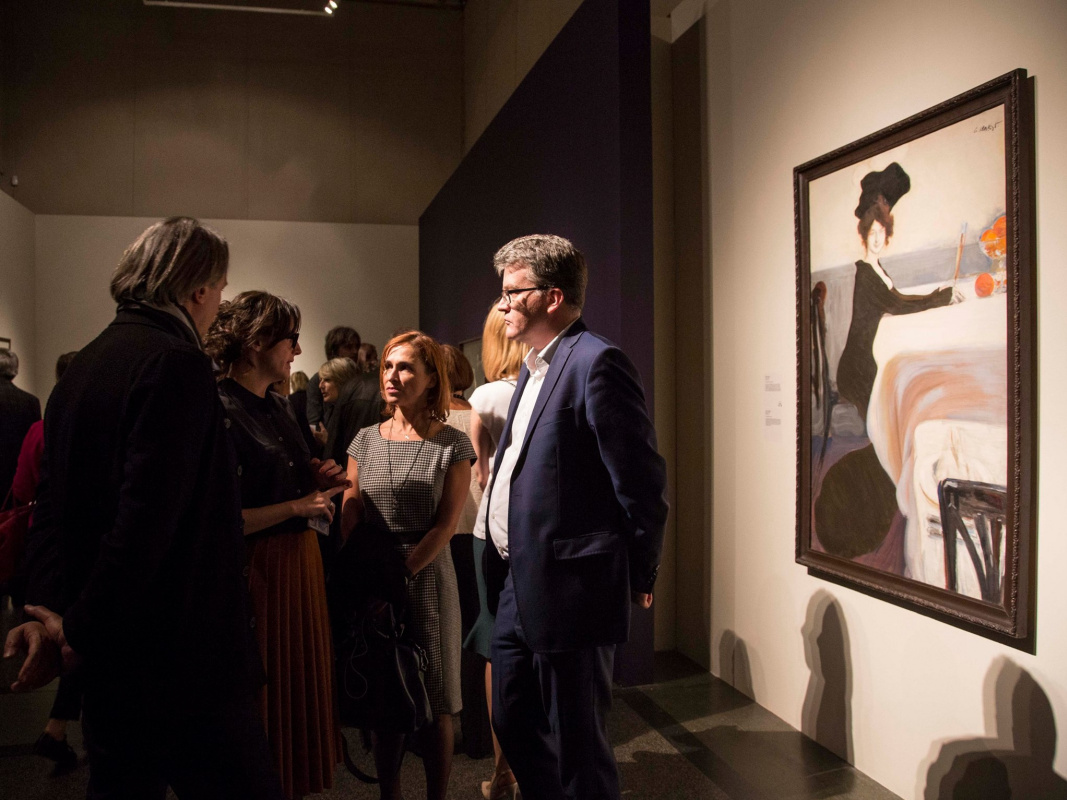log in
Enter site
Login to use Arthive functionality to the maximum
Dinner
Lev (Leon) Bakst • Painting, 1902, 150×100 cm
Description of the artwork «Dinner»
Bakst’s Dinner painting depicts Asya, the wife of Alexander Benois née Anna Kid. By the way, Bakst himself preferred to name this work Lady with Oranges or Lady in a Restaurant.
At the fifth exhibition of the Mir Iskusstva in February 1903, a scandal erupted around the Dinner. Even the Grand Duke Vladimir Alexandrovich and his wife reprimanded the artist for being obscene and too playful. What did the picture on an innocent subject shock the sophisticated public with?
The ideologist of the Wanderers, Vladimir Stasov criticized Bakst’s Dinner, leaving no stone unturned. He called the woman “a cat in a lady’s dress”, and the picture itself — an unbearable thing. “...Her muzzle is round plate-shaped, wearing some kind of horned headdress; the skinny paws in ladies’ sleeves are stretched out to the table, but she herself looks away, as if the dishes placed in front of her do not match her
taste, and she needs to steal something else from the side; her waist, her whole body and figure are feline, as disgusting as those of Beardsley, the English poseur and freak.”
The comparison with Beardsley is quite appropriate, whereas Stasov’s judgment is
debatable. Léon Bakst really painted the picture in the Art Nouveau style. And the subject’s feline grace is a nice feature. With the outward restraint of the subject matter, the depicted woman is bewitchingly sensual and alluring. And the
situation itself can cause different interpretations. Is she going to dine alone in the restaurant? We surely know what kind of girls go alone to restaurants!
An exquisite headdress, a rich outfit, a fur boa casually thrown over the back of her chair — the lady is clearly well-off (and some pious man from aside could ask where did she get it from). And the most unbearable thing is her daring look! Beautiful
women depicted alone were always blamed for that! Be it the scandalous Olympia by Manet, or the legendary Unknown Lady by Kramskoy, or the woman from the café in the painting by Repin who challenged Parisian society. All the painters were called over the coals for these pictures, and much more were the subjects themselves!
Beside the reproaches for immorality, Bakst heard a lot of impartial things about its primitive colouring. Moral issues aside, but the latter statement is unequivocally challenged. With the minimum of the hues, Bakst showed his masterly possession of colour, depicting surprisingly rich transitions, overflows, shades and contrasts. Take alone the tablecloth folds!
There were also positive reviews for the Lady with Oranges. For example, the critic and philosopher Vasily Rozanov was delighted with the picture. In the lady, he saw a stylish, thin decadent woman “with a smile à la Gioconda”. By the way, here is a curious and funny nuance. Perhaps, the organizers of the exhibition contributed to the scandal around the Dinner. Either by chance, or by someone’s intention, Malyavin’s Three Women appeared next to Bakst’s elegant modern lady. The spectators’ involuntary comparison of the two images suggested many thoughts: strong peasant women and an elegant decadent lady. They are so different! Are they that much different? So far apart! Oh, are they really far? These nearby hypostasis of femininity could not but excite the visitors of the exhibition,
because the talk about the Dinner did not fizzle out for a long time.
Written by Aliona Esaulova
At the fifth exhibition of the Mir Iskusstva in February 1903, a scandal erupted around the Dinner. Even the Grand Duke Vladimir Alexandrovich and his wife reprimanded the artist for being obscene and too playful. What did the picture on an innocent subject shock the sophisticated public with?
The ideologist of the Wanderers, Vladimir Stasov criticized Bakst’s Dinner, leaving no stone unturned. He called the woman “a cat in a lady’s dress”, and the picture itself — an unbearable thing. “...Her muzzle is round plate-shaped, wearing some kind of horned headdress; the skinny paws in ladies’ sleeves are stretched out to the table, but she herself looks away, as if the dishes placed in front of her do not match her
taste, and she needs to steal something else from the side; her waist, her whole body and figure are feline, as disgusting as those of Beardsley, the English poseur and freak.”
The comparison with Beardsley is quite appropriate, whereas Stasov’s judgment is
debatable. Léon Bakst really painted the picture in the Art Nouveau style. And the subject’s feline grace is a nice feature. With the outward restraint of the subject matter, the depicted woman is bewitchingly sensual and alluring. And the
situation itself can cause different interpretations. Is she going to dine alone in the restaurant? We surely know what kind of girls go alone to restaurants!
An exquisite headdress, a rich outfit, a fur boa casually thrown over the back of her chair — the lady is clearly well-off (and some pious man from aside could ask where did she get it from). And the most unbearable thing is her daring look! Beautiful
women depicted alone were always blamed for that! Be it the scandalous Olympia by Manet, or the legendary Unknown Lady by Kramskoy, or the woman from the café in the painting by Repin who challenged Parisian society. All the painters were called over the coals for these pictures, and much more were the subjects themselves!
Beside the reproaches for immorality, Bakst heard a lot of impartial things about its primitive colouring. Moral issues aside, but the latter statement is unequivocally challenged. With the minimum of the hues, Bakst showed his masterly possession of colour, depicting surprisingly rich transitions, overflows, shades and contrasts. Take alone the tablecloth folds!
There were also positive reviews for the Lady with Oranges. For example, the critic and philosopher Vasily Rozanov was delighted with the picture. In the lady, he saw a stylish, thin decadent woman “with a smile à la Gioconda”. By the way, here is a curious and funny nuance. Perhaps, the organizers of the exhibition contributed to the scandal around the Dinner. Either by chance, or by someone’s intention, Malyavin’s Three Women appeared next to Bakst’s elegant modern lady. The spectators’ involuntary comparison of the two images suggested many thoughts: strong peasant women and an elegant decadent lady. They are so different! Are they that much different? So far apart! Oh, are they really far? These nearby hypostasis of femininity could not but excite the visitors of the exhibition,
because the talk about the Dinner did not fizzle out for a long time.
Written by Aliona Esaulova



